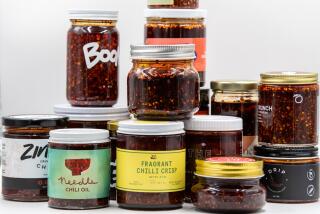New Mexico’s dwindling chile crop has farmers anxious
Reporting from HATCH, N.M. — Every year before the chile harvest, bad memories of 2009 stew in the back of Faron Lytle’s mind.
That was the year the chile farmer was forced to plow under a large portion of his red chile fields because he couldn’t find enough hands for the harvest. He can still “smell the good” of the state’s iconic crop — 50 tons of it — as the harrow disked the plants into the earth.
Fearful of a repeat, Lytle only planted 36 acres last year. This year, feeling a bit more confident, he planted about 70 acres. Still, it’s a rough time to be growing New Mexican chiles.
Hit with a combination of punches that include a labor shortage, drought and increasing competition from Mexico, China and India, New Mexico chile farmers remain concerned with every pepper they plant.
“I just got my fingers crossed, hoping and praying that we can get it all picked,” Lytle said soon after planting the chiles on his land in May.
In New Mexico, the chile is much more than an agricultural crop. Chiles are considered the heart and soul of this Southwestern state, where they are not only essential to its food, but to its art and culture.
Even the official state question is “Red or Green?” — referring to the kind of chile one prefers when ordering New Mexican cuisine. Some people opt for half and half, ordering their meal “Christmas.”
Harvested acreage of New Mexico chiles has declined from 35,000 acres in 1992 to less than 9,000 in 2013, according to the New Mexico Chile Assn. Last year’s harvest was the smallest in recent memory.
This fall, the green chile harvest is about to wrap up, and industry observers and farmers will be uncertain of the year’s outcome until the red chile harvest ends after the first frost. Some fear it will also be a bad year.
Labor turned out not be a challenge this year for Lytle and his father, Jimmy Lytle, a third-generation chile farmer with the legacy of being the son of the man who developed the Big Jim chile. The Big Jim is a popular pepper known for its long, tasty and fleshy pods that are ideal for chiles rellenos.
However, a mild spring, when plants grew slowly, and torrential downpours in the fall delayed the picking. The rain even drowned 4 acres of green chiles Lytle planted for seed.
Although most of the chile crop won’t be a loss because it can still be harvested when it turns red, Lytle will probably lose out on some profit. Fresh green chiles are more popular and sell for a better price than red chiles.
Growers point out that there’s only about a 7-day window in which a green chile must be picked before it begins turning red.
Chile peppers, a New World crop, can be traced to New Mexico at least back to the 1500s. That’s when early Spanish explorers first mentioned it in written records, said Stephanie J. Walker, a vegetable specialist at New Mexico State University in Las Cruces. (Though the chile is an official state vegetable, it is often classified as a fruit.)
It’s still up for debate as to whether the Spanish or the native peoples who traded up and down the Rio Grande corridor introduced the pepper to the region, Walker said.
Communities in northern New Mexico have long raised the native Chimayo chile, but around 1900, the long green chile that has become synonymous with New Mexico was developed.
This opened the way for processing and canning. Chiles obtained widespread popularity by the 1970s, and yields peaked in the mid-1990s.
But after the North American Free Trade Agreement of 1994, New Mexican chile farmers couldn’t compete with Mexican chile producers who could pay lower wages for hand labor, said Walker, who has worked in the chile industry for 35 years.
Eddie Diaz, who grows chiles in Deming, said his chile pickers make at least $10 an hour, and good pickers, who get paid by the bucket, can make twice as much. Still, farmers struggle to find workers.
“It’s not easy work,” Diaz said. Workers have to kneel on the dirt to pick the fruit carefully by hand. He needs about 50 field hands for harvest time.
The New Mexico chile industry — which touts itself as having the best chiles in the world because of its altitude, climate, soil and farmers — supports more than 4,000 jobs and contributes more than $400 million every year to the state’s economy, according to the governor’s office.
In an effort to protect their peppers from counterfeiters trying to cash in on the reputation of New Mexico chiles, the state launched a certification program in August similar to other well-known product labels, such as “100% pure Florida” and “California olive oil.”
The “New Mexico certified chile” mark can be placed on the crop and used in marketing and advertising to let consumers know their chile is not an imitation, said Jaye Hawkins, executive director of the New Mexico Chile Assn.
But other challenges remain.
Though the area of Deming and Hatch, where much of the chile crop is grown, received considerable rain recently, it still won’t end the state’s long-term drought. A healthy snowpack in the mountains to the north is what’s needed to replenish water supplies, experts said.
The Lytle farm hasn’t received water from Elephant Butte Lake in four years because it’s nearly dry. Lytle relies on wells to pump water from the aquifer, an expensive proposition.
But Lytle said his family’s farm was surviving, for now, and trying to keep the customers they already have. Frankly, he said, he can’t see himself doing anything else for a living.
Besides, he has to have fresh chile with every meal. It’s not so much a “craving,” he said, as an “addiction.”
“It’s in our blood. It’s all we know,” he said. “My stomach is still burning from the chile I had for lunch.”
Twitter: @TheCindyCarcamo
More to Read
Sign up for Essential California
The most important California stories and recommendations in your inbox every morning.
You may occasionally receive promotional content from the Los Angeles Times.











